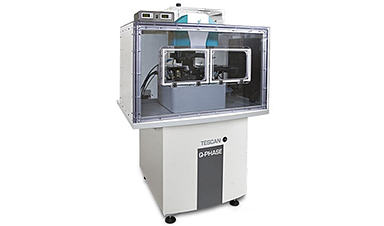The University of North Florida Materials Science and Engineering Research Facility (MSERF) has partnered with TESCAN, a leading manufacturer of electron and light microscopes, in the installation of one of its new Q-Phase microscopes, a unique instrument for quantitative phase imaging based on holographic microscopy.
The Q-Phase microscope is a one-of-a-kind holographic microscope capable of imaging live cells for up to five days. Traditional light microscopy of cells requires staining and chemical treatments that capture the state of the cell in time but kills the cell in the process. This new technology allows cells to be imaged while living over the course of days.
“The partnership with TESCAN affords the University the ability to gather cutting-edge data from the latest high-tech equipment” said Dr. Paul Eason, UNF-MSERF director and associate professor of mechanical engineering in the College of Computing, Engineering and Construction.
The agreement between the University and TESCAN provides UNF the opportunity to house brand new and unique microscopes for the purpose of instrument validation and demonstration for potential users. The Q-Phase microscope, housed at MSERF in the newly renovated Skinner-Jones Hall, is on the UNF campus for a 90-day trial installation.
Researchers both at UNF and the Mayo Clinic are taking advantage of the trial installation and utilizing the high-powered device in their respective studies of treating various types of cancer.
Image Credit: AZO Nano
News This Week
Scientists Melt Cancer’s Hidden “Power Hubs” and Stop Tumor Growth
Researchers discovered that in a rare kidney cancer, RNA builds droplet-like hubs that act as growth control centers inside tumor cells. By engineering a molecular switch to dissolve these hubs, they were able to halt cancer [...]
Platelet-inspired nanoparticles could improve treatment of inflammatory diseases
Scientists have developed platelet-inspired nanoparticles that deliver anti-inflammatory drugs directly to brain-computer interface implants, doubling their effectiveness. Scientists have found a way to improve the performance of brain-computer interface (BCI) electrodes by delivering anti-inflammatory drugs directly [...]
After 150 years, a new chapter in cancer therapy is finally beginning
For decades, researchers have been looking for ways to destroy cancer cells in a targeted manner without further weakening the body. But for many patients whose immune system is severely impaired by chemotherapy or radiation, [...]
Older chemical libraries show promise for fighting resistant strains of COVID-19 virus
SARS‑CoV‑2, the virus that causes COVID-19, continues to mutate, with some newer strains becoming less responsive to current antiviral treatments like Paxlovid. Now, University of California San Diego scientists and an international team of [...]
Lower doses of immunotherapy for skin cancer give better results, study suggests
According to a new study, lower doses of approved immunotherapy for malignant melanoma can give better results against tumors, while reducing side effects. This is reported by researchers at Karolinska Institutet in the Journal of the National [...]
Researchers highlight five pathways through which microplastics can harm the brain
Microplastics could be fueling neurodegenerative diseases like Alzheimer's and Parkinson's, with a new study highlighting five ways microplastics can trigger inflammation and damage in the brain. More than 57 million people live with dementia, [...]
Tiny Metal Nanodots Obliterate Cancer Cells While Largely Sparing Healthy Tissue
Scientists have developed tiny metal-oxide particles that push cancer cells past their stress limits while sparing healthy tissue. An international team led by RMIT University has developed tiny particles called nanodots, crafted from a metallic compound, [...]
Gold Nanoclusters Could Supercharge Quantum Computers
Researchers found that gold “super atoms” can behave like the atoms in top-tier quantum systems—only far easier to scale. These tiny clusters can be customized at the molecular level, offering a powerful, tunable foundation [...]














Leave A Comment